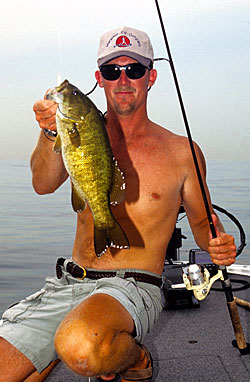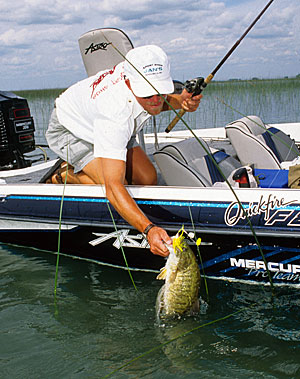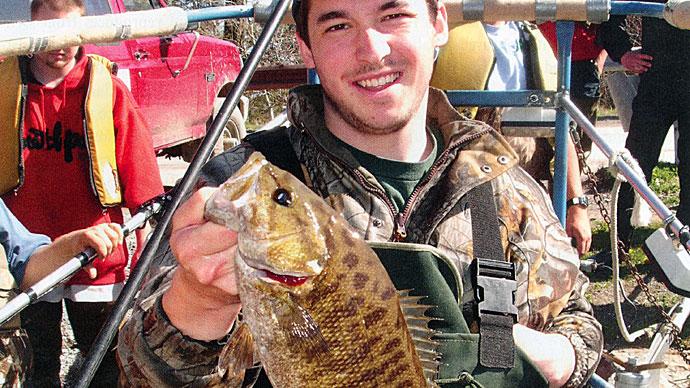
When you think of fish that migrate or travel extreme distances, you naturally think of tuna or anadromous salmon that wander over thousands of miles in the Pacific Ocean before running another thousand miles up rivers from the Pacific Coast as far as Idaho. Even potamodromous salmon in the Great Lakes migrate from southern Lake Michigan and Lake Huron into natal rivers hundreds of miles away.
Walleyes are known to have a wanderlust that has taken them from Lake Erie only to be recovered in northern Lake Huron over only a few weeks. Smallmouth bass have always been thought to be homebodies, never traveling far from a given habitat or territory. But studies have shown that smallmouth bass may travel more than you think.
While interviewing bass guide Chris Noffsinger of Northern Adventures Fishing and Guide Service (northernadventuresfishing.com) for an article on smallmouth bass in Michigan, he shared that he’d caught bass in Lake Charlevoix and Grand Traverse Bay that were tagged near Waugoshance Point and Beaver Island. That’s more than 70 miles away and would require that the bass travel over water several hundreds of feet deep. The feat was enlightening, considering bass are generally thought of as homebodies that do not traditionally stray far from a given territory. Studies done on Lake Michigan would seem to indicate that smallmouth wander farther than you think.
The tagged bass that Noffsinger recovered are the result of studies by graduate students under the guidance of Dr. Tracy Galarowicz, Professor and Chair of the Department of Biology at Central Michigan University, and work done by the Michigan Department of Natural Resources fisheries division. The studies centered on the Beaver Island Archipelago, which means group of islands, Waugoshance Point and northern Lake Michigan.
The primary focus of the studies was to track the movement of smallmouth bass and the influence of habitat and environment on nest sites and nesting success. The studies were conducted mainly by doctorate candidates Mark Kaemingk, Alexander Clem, and MDNR personnel over several years beginning in 2007. Beaver Island and the other areas were chosen because they are relatively isolated, and there was data to compare from similar studies done back in the 1950s. Although restricted to a relatively small area, the results provide insights into smallmouth populations across the Great Lakes and anywhere brown bass are found.
One reason bass move great distances is food. It’s logical to assume that bass follow pelagic schools of baitfish, like alewives or shad. Alewives periodically move into large inland lakes and river mouth lakes connected to the Great Lakes. But according to MDNR Fisheries Research Biologist John Clevenger, that probably is not the case. “Studies have shown that ninety-nine percent of the diet of Great Lakes smallmouths is gobies and crawfish.” That’s one reason why tubes are such an effective lure for Great Lakes smallmouths because they can be skittered along the bottom just like their prey does.

It would also seem to shoot a hole in the theory that smallmouth movement is tied to roving schools of baitfish. Bass can find ample food sources right where they live or within a relatively short distance. Bass were found not to be afraid of traveling to find new food sources depending on energy requirements. Forays took them from daytime lairs to the feeding grounds during prime feeding time, so when you fish may be as important as where.
The one reason smallmouth bass in the Great Lakes might travel long distances is that they can. It’s the big fishbowl versus little fishbowl theory. Bass in a smaller body of water have nowhere to go, so they are less inclined to travel, but fish in a massive body of water, like the Great Lakes, are not confined by the size of the fishbowl. The study speculated, “Fish movement may vary across a wide array of aquatic ecosystems and may be related to the overall size of the system inhabited.”
“Two smallmouth bass in the study emigrated outside the Beaver Island Archipelago, suggesting this population may be more ‘open’ in terms of individuals moving throughout northern Lake Michigan than previously thought.” These are likely the bass that Noffsinger caught in Lake Charlevoix and Grand Traverse Bay. “The results indicate smallmouth bass may move greater distances in larger aquatic systems; therefore, larger management units need to be established to account for bass movements.”
Bass may move deeper each day because it is more comfortable, too. Lake Michigan stays relatively cool year-round, but near-shore waters could reach uncomfortable levels for summer bass. “Greater movement distance during the tracking periods could be due to the size of the smallmouth bass tagged in this study; more extensive movements have been recorded for bass greater than 400 mm (15.74 inches). Larger smallmouth bass may be more mobile than smaller conspecifics and more likely to move greater distances. Increased daily food requirements for larger bass, as opposed to smaller conspecifics, may cause bass to search larger areas to meet these higher energy demands.”
In one of the studies, 16 smallmouth bass were surgically implanted with ultrasonic transmitters within the Beaver Island Archipelago in northern Lake Michigan. To determine daily movement patterns, a maximum of one location per individual was recorded daily during three specific tracking periods – pre-spawn, spawning, and post-spawn. The movement was evaluated as site fidelity, minimum displacement rate, maximum excursion rate, and distance from shore.

The study showed, “Smallmouth bass exhibit greater maximum excursion rates during the spawn-period compared to pre-spawn. It was found that both sexes moved farther offshore to deeper water during the post-spawn, but females were located farther offshore than males during this period.” This information is essential to anglers fishing during the summer months. Larger female bass are more likely to be caught in deeper water, far removed from the shallows where smaller male bass will congregate.
“Sex-related differences in movement could coincide with differential energy demands in which male smallmouth bass need to forage more in near-shore areas because large amounts of energy are expended during nest guarding, especially in the presence of nest predators.” For fishermen, this likely means smaller male bass are more likely to be caught because they are hungrier and need to make up for energy expended during the spawn.
Those who fish a given body of water numerous times throughout a year soon discover that certain areas produce time after time. There may be a prominent weed edge, a group of boulders, or a big old stump in an otherwise structure-less flat that always seems to produce a good fish. It’s like a trout in a stream that has picked a prime location behind a submerged log. Catch that trout, and another will take its place. Bass are no different.
The study found that male bass rarely returned to the same spawning area the following year, whereas half of the female bass returned to the same site. During the post-spawn, both sexes of bass were very likely to return to the same area. “Bass during the post-spawn are likely recovering from high energy losses due to spawning and preparing for overwintering by consuming large amounts of food. Post-spawn foraging success in previous years may result in the return to these sites each year since individuals are more like to stay in certain areas that will maximize their fitness.”
“Our results suggest that daily movement may not be related to the size of the system inhabited, but rather a function of prey availability or some abiotic factor such as temperature.” That’s probably not true of seasonal movements.
These studies show that bass may not be the homebodies that we think they are. Females tend to show more site fidelity during the spawn than promiscuous males. Post-spawn bass can be counted on to return to greener pastures to gorge and bulk up for the winter, but some bass have a wanderlust that takes them farther than anyone ever imagined. The size of the pond only limits that.




